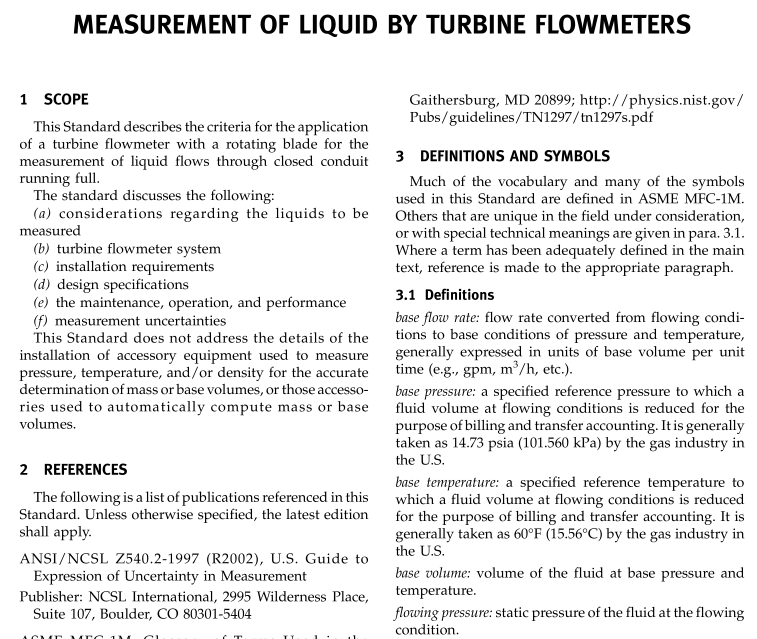ASME MFC-22 pdf download

ASME MFC-22 pdf download Measurement of Liquid by Turbine Flowmeters
6.2.2 If a bypass is permitted around a meter or a battery of meters, it should be provided with a blind or a positive shutoff, double block-and-bleed valve with telltale bleed. The bypass should be sealed with a tam- perproof seal if the meter or battery of meters is used for fiscal measurement.
6.2.3 All valves, especially spring-loaded or selfclosing valves, should be designed so that they will not admitair when they are subjected to vacuum conditions.
6.2.4 Valves for intermittent flow control should be fast acting and shock-free to minimize the adverse effects of starting and stopping liquid movement.
6.3 Piping
6.3.1 Turbine meters are normally installed in a horizontal orientation. The manufacturer should be con- sulted if space limitations dictate a different orientation for the meter.
6.3.2 Where the flow range is over the limit of any one meter or the prover for the system, a bank of meters may be installed in parallel. Each meter in the bank of meters should operate within its minimum and maxi- mum flow rates. A means should be provided to balance flow through each meter. Generally, balance of flow rate can be accomplished by using a flow control valve installed downstream of each meter run.
6.3.3 Meters should be installed so that they will not be subjected to undue stress, strain, or vibration. Provision should be made to minimize meter distortion caused by piping expansion and contraction.
6.3.4 Measurement systems should be installed so that they will have a maximum, dependable operating life. This requires that, in certain services, protective devices be installed to remove liquid abrasives or other entrained particles that could impair meter performance characteristics or cause premature wear. If strainers, fil- ters, sediment traps, settling tanks, water separators, a combination ofthese items, or any other suitable devices are required, they should be sized and installed to pre- vent flash vaporization of the liquid before it passes through the meter. Protective devices may be installed singly or in an interchangeable battery, depending on the importance of continuous service. In services where the liquid is clean or the installed meter does not require or warrant protection, omission of protective devices may be acceptable. Monitoring devices should be installed to determine when the protective device needs to be cleaned.
6.3.5 Measurement systems should be installed and operated so that they provide satisfactory performance within the viscosity, pressure, temperature, and flow ranges that will be encountered.
6.3.6 Meters should be adequately protected from pressure pulsations and excessive surges and from excessive pressure caused by thermal expansion of the liquid. This kind of protection may require the installa- tion of surge tanks, expansion chambers, pressure-limiting valves, pressure relief valves, and/or other protective devices. When pressure relief valves or pres- sure-limiting valves are located between the meter and the prover, a means of detecting spills from the valves should be provided.
6.3.7 Conditions that contribute to flashing and/ or cavitation of the liquid stream as it passes through the meter should be avoided through suitable system design and operation of the meter within the flow range specified by the manufacturer. A typical liquid turbine meter performance curve illustrating the effect of back pressure is shown in Fig. 6. This deterioration of meter performance can be avoided by maintaining sufficient pressure within the meter. This may be accomplished by placing a back-pressure valve downstream of the meter to maintain pressure on the meter and the prover above the vapor pressure of the liquid. In some operations, the normal system pressure may be sufficient to prevent flashing and/or cavitation without the use of a back-pressure valve.
Since the meter outlet pressure requirement is dependent upon the fluid conditions and the meter selection, the meter manufacturer should be consulted for recommendations on the minimum acceptable operating pressures for specific applications. 6.3.8 In the absence of a manufacturer’s recom- mendation, the numerical value of the minimum pres- sure at the outlet of the meter may be calculated with the following expression, which has been commonly used. The calculated pressure has proven to be adequate in mostapplications and itmay be conservative for some situations.









